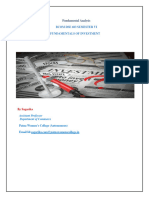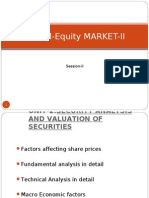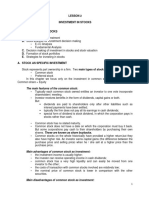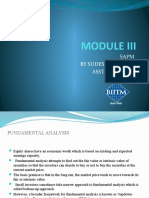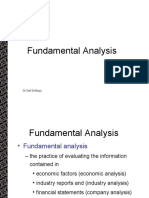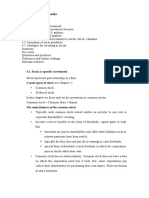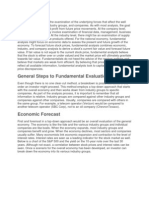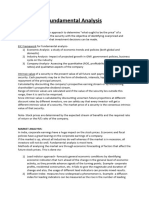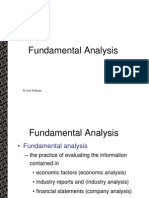0 ratings0% found this document useful (0 votes) 119 views8 pagesEIC Framework - IAPM
Investment Analysis & Portfolio Management
Copyright
© © All Rights Reserved
We take content rights seriously. If you suspect this is your content,
claim it here.
Available Formats
Download as PDF or read online on Scribd
ant
EIC Framework (To be done from Rohini Singh)
Fundamental/Economic Analysis
Fundamental or economic analysis deals with macro level analysis of economic variables by
Which the prospective of the economy is analysed. Before investing into any stock market,
institutional investors are interested in the present and future growth prospects of that market.
UCT Ce Wasco re
| whic country or economy weshould invest in
wy
(More
In which industry we should vest in
vy
Comapny Analysis
Inwhich company stock we should best in
Parameters of Fundamental analysis: JS
Leading and lagging indicators: leading indicators are those indicators when the
happening of one event in the present will directly affect the happening of another event
in future, E.g. if there is good rainfall then the agricultural production will also be good.
Similarly, fall in rupee will adversely affect the import of India.
Lagging indicators are those indicators when some time lag is involved in the happening,
of causal event and when the impact of that event will be seen. E.g. unemployment rate.
2.Per-capita Income: if per-capita income of a country is high then the people will have
‘more saving for the investment purpose. On the other hand, if the per-capita income of
«country is less then greater proportion of total income will be used in consumption,
3.Growth rate of economy: high GDP growth rate is the indication that agriculture sector,
industrial sector, and service sector are doing well and people will have more income
level. Hence high income will be used for investment purpose.
4.Autitude of other investors- FI and FDI trends:
If FIL and FDI is showing an upward trend it indicates that investors are optimistic
towards that economy.
‘S.Anflation rate: there is an inverse relationship betw:
inflation rate. A high inflation rate in Senay wil end a do as
inf wnward trend in stock
7.Imernal political and savial events
‘Seamed ih canseanne
ye�yh Regeopinies cg. tO) conduss Ss
ecenaters Creamy. dates) orem af GPF éomci °
Capi peratton, crammgton epenll . ea
8.Budget analysis: a budget is a record of all expenditure’s items and revenue items.
the help of the budget of the govt. it can be find out how much funds will be used for
the progress of economy or creation of infrastructure for the economy and how much
fund will be used for non-development activities such as subsidies, social benefits,
defence expenses, pension to retired employees, setting off the loans ete.
9.Index of industrial production: if index is showing an upward trend it means industries
are growing and hence it is profitable to invest in that industry.
10. Index of agricultural production: we can gauge the state of an economy by looking at
above indic of economic growth, ree!
risun cconducted we qek afect of He germal public epinion on
poe 4 cera een oer eek i go ae 8
ard Comprrd overtime,
Industry Analysis
Industry analysis is carried out to see the present & future growth prospects of the industry. In
other words, with the help of industry analysis the strength and weaknesses of the industry is
analysed,
Industry classification On (he Basis OF Business Cycleay
/- Growth industry: these are those industry which are growing over a period of time
irrespective of any growth rate. Hence these are often independent of business cycle.
Generally characterised by expectation of abnormally high rate of expansion in earning.
E.g. growth stocks, cellular phones.
Cyclical industry: these are those industries which grow when there is good economic
growth rate in the economy and declines when there is no growth in the economy. In
other words, the growth of the cyclical industry is very much sensitive to the economic
growth rate. E.g, FMCG, Consumer durables, Hospitality industry, Capital gore
Defensive industries: these are those industries where the growth rate is totally
insensitive to the growth rate of the economy. In other words, the growth rate of the
economy has no impact upon thé sales of the industry. E.g, pharma, education, food-
processing industry.
Cyclical growth industries: these are those industries where growth rate of the economy
hhas substantial (neither more nor less) impact upon the growth rate of these industries.
E.g. housing splay transportation sector, airline industry.
Qualitative analysis of industry:
There are different qualitative factors which have impact on the industry performance: key
characteristics in industry analysi
i Attitude of govt. towards particular indust ,
Govt. has passive attitude which is restrictive in nature towards- chemical, tobacco,
X CAD —_
cigar ete 2)
Ath? +p Govt atfitude: a) passive attitude b) progressive attitude |
A Progressive attitude allows the industry to grow e.g. small-scale business, IT,
Wescccr rastructure.§ Asdz~>) a a
5
————
‘Seamed ih canseanne�4
Altitude Sf general public$
i General Public has al Dassi |
has passive attitude of, i |
Labour avail labilit tone
Any industry which has
of Competitive advantage:
bright future for its existence is reflected to be more powerful,
bsolute cost at : ownership of resource, patent, monopolistic reach to
low cost_material, efficiént cost reduction and coritrol system, location
se, experience curve & leaming effect. an
Past sales and e nr
.. Past sales and earings performance oO
a
Models of Industry analy:
ve
og
A. Stages of the life cyel aa
Introduction or the pioneering stage ¢))
or
Y Growth stage
3¢ Maturity stage k
) Gf Decline stage
. Michael E, Porter approach to industry analysis:
Potential threat of new product
Existing industry competitors
Suppliers’ negotiation power
Buyers’ negotiation power
Threat of substitute
yeepegs
SWOT analysis
Past Performance
yo
‘Company Analysis
Company analysis stands for analysing the company’s strength and weaknesses, threats and
opportunities. With the help of the company analysis the growth prospects of the company
are analysed. Company analysis can be done in following two ways:
1. External analysis; it can be done be valuing the preference shares and common
equity shares of the company.
2. Intemal analysis: it can be done by understanding the income statement and
financial statement of the company. The intemal analysis of the co. can be done by
calculating the different accounting ratios.
A. External Analysis
i, Valuation of redeemable preference share
Valuation of irredeemable preference share
Valuation of common equity shares
‘Seamed ih canseanne�8. DDM model (no growth model or constant dividend model, constant
growth model, two stage growth model, multi stage growth model)
b. Relative valuation (P/E multiplier and PBV ratio approach)
© Single period valuation and Multiperiod valuation
B, Internal Analysis
Trcan be done by analysing the income statement and financial statements,
Analysing financial statement
Common size statements
ii, Index number trend se
Ratio analysis,
DuPont Anal
+ Helps identify areas of strength and weakness
* breaks down return on equity (ROE) into:
a. profitability of sales
b. efficiency in usage of assets
©. financial leverage
ratios - short term'solvency
Current Ratio= Current Assets/Current Liabilities
Quick Ratio= (Current Assets- Inventory)/Current Liabilities
* Cash Ratio= Cash / Current Liabilities
. . . ”
Leverage ratios - debt inthe capital structures xem Le A)
angers
+ Debt’ Equity Ratio (D/E) = Total Deby/Total Equity ae
* Equity Multiplier = Total Assets/Total Equity
Coverage Ratios ability to service deb “4 Zz are ]
+ Interest Coverage RatioEBIT/Interest@ inst) |
+ Cash Coverage (Int io =(EBIT +Depreciationy/Interest 7 |
+ Debt Coverage Rati Interest + Proporti
Market Value Ratios
+ Price Earnings Ratio (P/E) = Market Price per Share/ Earnings per Share
* Book to Market Ratio = Book Value per Share/ Market Price per Share
al (1 -tax rate)}
Asset Utilization Ratios (Operational Ratios):
+ Inventory Tumover Ratio = Cost of Goods Sold/Inventory
+ Receivables Tumover Ratio = Sales/ Accounts receivable
+ Total Asset Turnover ratio = Sales/Total assets
Ret taro Or PA
po. of equity Sha
EPs >
‘Seamed hansen�Profitability Ratios - returns on sales or investment
+ (Profit Margin ratio = Net Income/ Sales
+ Return on Assets ( fet Incomae
2/ Return on Equity (ROE):
Interpreting Ratios:
* Study the trends over time- comparable periods
Compare with peers — not whole industry
Be careful in interpretation- e.g. P/E ratio may “improve” when earnings fall
The past may not repeat itself
+ Long term Lenders e.g. bankers, debenture holder: leverage and coverage ratio
~
* Short term creditors: liquidity ratio z=
* Equity shareholder: all ratios, preferably operational, profitability and market value
Talia.
ss Bp Po porte Conporstion in 1920)
Dy Powe Ns
Dy Pow Ames
i So foe ; /
Fn acne , uctomente » Rramaint lence
2 Aredyses
S(b
pore Pe Retin -for thei
2 How CA Cot
St Co. con T ihe a /
D We Co .
“wo ele ea Salo-
; Bffectinety es ih sels oye were,
3 tus nigh cfinancinl Lene mm
fincas week auc Myth ry a |
7 hfe can fulter be decomposeel to pave “ |
> Deperr eqn: re w be dete e ogin oO
oe a jato EST googie) Tax Brcdeee & Tot. |
broken « |
% Ase
wel Gnome 4, Sales « ese
foe = SE ate Teer enanem Send oy,
= Sabb .
$ J Pe Pech Tianmte a quily multiplier
b Toons rau beitio
‘Seamed ih canseanne�De gout Crowwple 2—
eo Bore Co. Ia Same Anclushsy
o ket Ys us|, for Bettas
Rodis GA tei8
Hizaue Tage won of 1S),
Sa Pivek Tanorer os
Batact G ie) Lerernrs —
wil ply “ene ¥ 8 oa
> opestion of Gels are He tty tere wt even Hote
ae hove Same RoE
~) _ observations
Bo Ca A Is athe Xo genorocte. Cuyher Satis colle
Wwoldaint dower Cos fF goods eich Con
be tan
Ww Wy fastir worgie.
Qo. H is Betts ts troducts ot Lowen Wrargin
Gk have ‘rou Aeaet tumover Rotiy indicating
mae o ate wo. Cf Sal,
3 b. & a Bus Faby, Siren te Francia ®
| Lemeoge, & rey Low
doy Nora?
L5 Te Wabph inverters FO yaduuttend coat 1s achyatty Causing
Hie POE to be whee It Is
Mot We
a de withont
> pp cane [eT fe the Net Profi 4 ee eat Hee
jn Phe franck Larose Oy
IF ails do nereset Te Rropitevsltly:
Co. s
butt ts hte fb aes *
? In broncind Laren ye a
dur.
(> we Need do ste White eet Borers
Pree Avenorey Gadio ( Id Ts Te
a
ys due te Fla Pet Grofit mrogin on
WN) nr Only due to beteenge (wohicle
is Aleaming 5p),
‘Seamed hansen�enitD
ene
ERT
@ SOLVED EXAMPLES
CHAPTER 9 Company Analysis 193,
ols Le ng ExpetPt ate walle from the annual accounts of Mangalore Chemicals
wr Ce For the year ended 31 March 2014 (Rs Crore) 4 261
(es Earnings before interest and dep 247g Are 0
Depreciation anys PAT = 10-93
Interest 10245 per = X
Taxes 22.61 ERT = BOTT - Erdeeat
Profic after tax 70.93 = 196 102-45
Dividend and dividend distribution tax 14.22 eet cand
Ason 31 March 2014 (Rs Crore) CRT = BGT (1- Tar Pade)
Equity & Reserves 635.85 70-93 = 97-55 (i -Tar Robe)
Long term borrowing ( repayable over 7 years) 226.85
Other liabilities and provisions 129.6 (ip Tretate J = ES
‘Current Liabilities and provisions 1641.52
Toul 2633.88 = 6-758.
Fixed Assets 625.94
Orher assets 274.96
‘Currene Assets 1732.98
Total 2633.88
AusgDebUEquity ratio = 226.851224.76 = 1.009
Calculate three ratios that are relevant for a bond holder
[ BEE: 0.3567]
224-76 @lnterest coverage ratio = EBIT/interest = 224.76/102.45 = 2.19 [ \98 Jyorus- = rary]
UW
Fa Debt service coverage ratio - EBIT/Ginterestt annual installment for Long term
1%
borrowing/(1-tax rate)
First calculate the installment to be repaid = 226.8517 =3241
‘Then the tax rate =22.61193.54 = 0.2417 196
Soy
Debs service coverage ratio = 224.76/((102.45 (226.85/7)M(1-22.61193.54) «1,548 = C2 SEF PAD
The following information was collected for ACC Ld. oe.
ACC Led. (excerpts from Annual Accounts) = MOH
Balance sheet as at 31 December 2015 (Rs Crore)
‘Share Capital 187.95 Fixed Assets 7655.94
Reserves and Surplus 8255.09 Non Current Assets 1914.23
8443.04 Inventories 1188.6,
‘Seamed ih canseanne�194 Secuty Analysis and Portfolio Management
Non current Li 589.02 Trade receivables 484.35
Current Liabi 3808.76 Other current Assets 16977
“Total Liabilities T2RAO.AD Total Assets 12840.82
Face value per shate = Rs 10)
Prof icand Los s Account for the year ended 31 December 2015 (Rs Crore)
Revenue 1916.18
Expenditure 1132.21
Profit before tax 78397
Profit afer tax 591.57
Galeulate EPS, ROE, ROA, Profit Margin Ratio and Equity Mukipliet. What do you
br sm 9-3307 abate os = ES
¢ EPS 591.57/187.95 = 3.147 — ube —— = SU ST
ROE-S9LS7INGS 06.007 TER PRET yg dasot
ROA = 591.59/12840.82 -0.046 ERS = ae mao os
(ht income feats) Profit Margin Ratio = 591.57/11916.18 = 0.049
3
[E Ratio = Mothus hice
Do Pont:
Equity Mule
Profitability ratios are very low, even after leverage the return on equity is only 796.
Given below are excerpts from the accounts for Bajaj Auto Lid. for the Year ending 31
March 2016. Calculate P/E ratio and perform Du Pont analysis,
= 12840.82/8443,04 - 1.52
Income Statement Aare
Revenue 22688 /
Raw Material 35087,
EPs Employee cons a8 |
Other Expenses 1933 |
Operating Profit 3780 |
Depreciation 307, |
Interest a
Other income 33
Profit before tax 3335)
Tres 1733
Proht 3682
Balance sheet
Fauity ass
Reserves 32003
coed
Nek \ncome
enh:
a foted Aas
Mek intomt y Teaed eqpih:
Evergreen
rat Aveed ou
(pos) x eit’ raasnieliee)
. ees.
nek Zacomt ¢ SOY X Equity mathe
rok sich ae
(nein tie) 1 Der tanars Pao Cengty melt pt
Roe =
‘Seamed hansen



